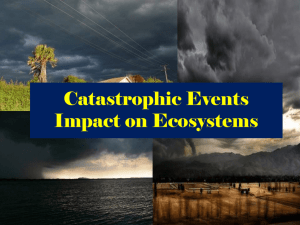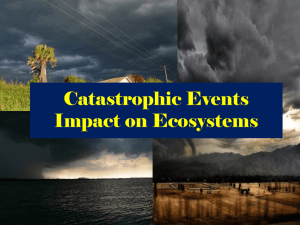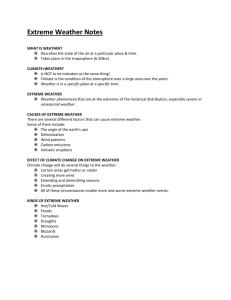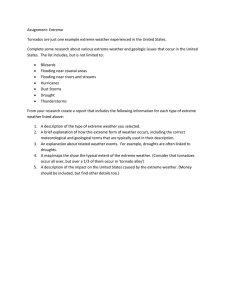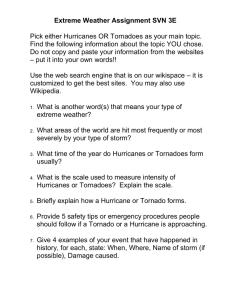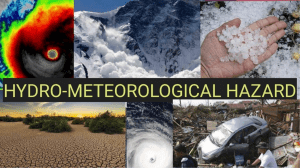Catastrophic Events Impact on Ecosystems
advertisement
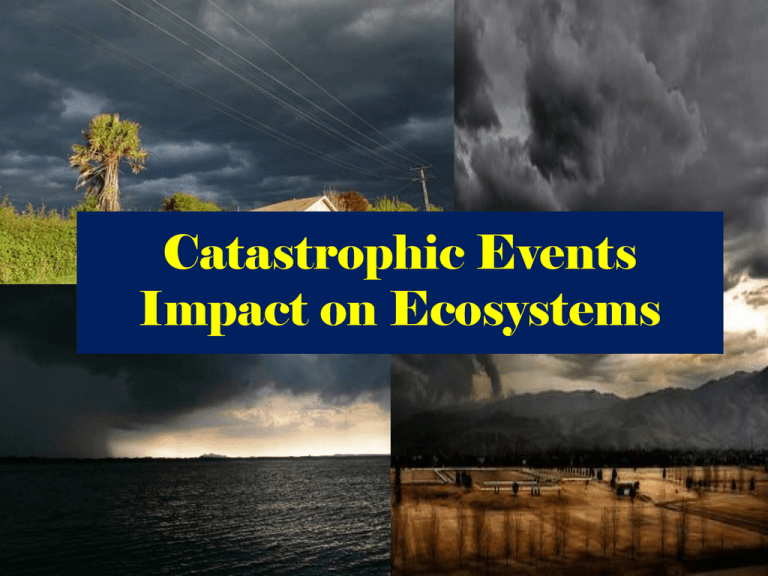
Catastrophic Events Impact on Ecosystems Hurricanes Hurricanes • An intense, rotating oceanic weather system with sustained winds of at least 74 mph and a welldefined eye • Conditions for formation: • Warm water • Light upper-level winds • Pre-existing disturbance of thunderstorms • Hurricanes produce damaging surface winds and storm surges Hurricane videos • http://www.youtube.com/watch?v=s76Qn7bp CsQ • http://www.youtube.com/watch?v=sXM5q1t GB6o&feature=pyv&ad=5241746182&kw=kat rina How Hurricanes Affect the Ecosystem Wind – Trees damaged, snapped, or uprooted http://www.nhc.noaa.gov /aboutsshws.php Storm Surge – The storm surge causes sediment to erode and shift. – Coastal wetlands and barrier islands take the brunt of the storm surge. – Sediment erosion and deposition often affect – Oyster beds – Coral reefs – Sea grass beds http://www.comet.ucar.edu/ns flab/web/hurricane/313.htm Salt Water Invasion! • Saltwater intrusion in lakes, streams, and wetlands change ecosystems (e.g. causes massive fish kills) • The storm surge kills tree species that are not tolerant of salt water. Flooding Moves Contaminants – Contaminants (e.g. chemicals used to treat crops or solid and liquid wastes) are transported into groundwater • Phytoplankton blooms lead to a decrease in dissolved oxygen Floods Floods • Is an overflowing of water onto land that is normally dry • Caused by intense or long term precipitation from thunderstorms, hurricane surges, or melting snow • Most impact results from paving the ground and the precipitation becomes runoff • Cause loss of life, disease, property damage or loss, contamination of water, and destruction of crops and livestock Environmental Impact of Floods • Floods are important in maintaining ecosystem habitats and soil fertility • Nutrients carried by floodwaters can benefit ecosystems and crops • Expand habitats for fish, birds • Recharge groundwater Environmental Impact of Floods • Flood-management practices have affected floodplains and the nature of flooding • Wetlands drained • Land cleared for farming • Upstream development that replaces natural vegetation with paved asphalt • Construction of channels, levees, reservoirs Effects of Floods Animals • Flooding forces many wild animals from their natural habitats. • Domestic animals are also left without homes after floods. • The large amounts of pooled water lead to an increase in mosquito populations. Runoff Flushes Away Contaminants • The sudden appearance of an overflow of water can wash away – Unneeded salt – Contaminants like chemical waste – Debris Tornadoes Tornadoes • A rotating column of air reaching from a thunderstorm to the ground. • The most violent tornadoes can have winds up to 300 mph. Tornado videos • http://www.youtube.com/watch?v=vhKjv9Gu ARQ • http://www.youtube.com/watch?v=TxsxKi0W gxU Tornadoes Effect on Ecosystems • Trees damaged, stripped, or uprooted • Open forest canopies to sunlight • Fallen trees offer shelter for small animals • Potential destruction of waste storage or treatment facilities or chemical plants Earthquakes Earthquake Earthquakes • Is the vibration of the Earth’s surface that occurs after a release of energy in the crust • This release of energy can be caused by a volcanic eruption, or movements of the crust Earthquake videos Tsunami Tsunami • Are large ocean waves produced by earthquakes, volcanic eruptions, or underwater landslides • The waves can travel upstream in coastal estuaries and rivers • Areas of risk are less than 25ft about sea level and within one mile of shore • Impact includes drowning, flooding, contamination of water, fires from broken gas lines, etc. Tsunami video
